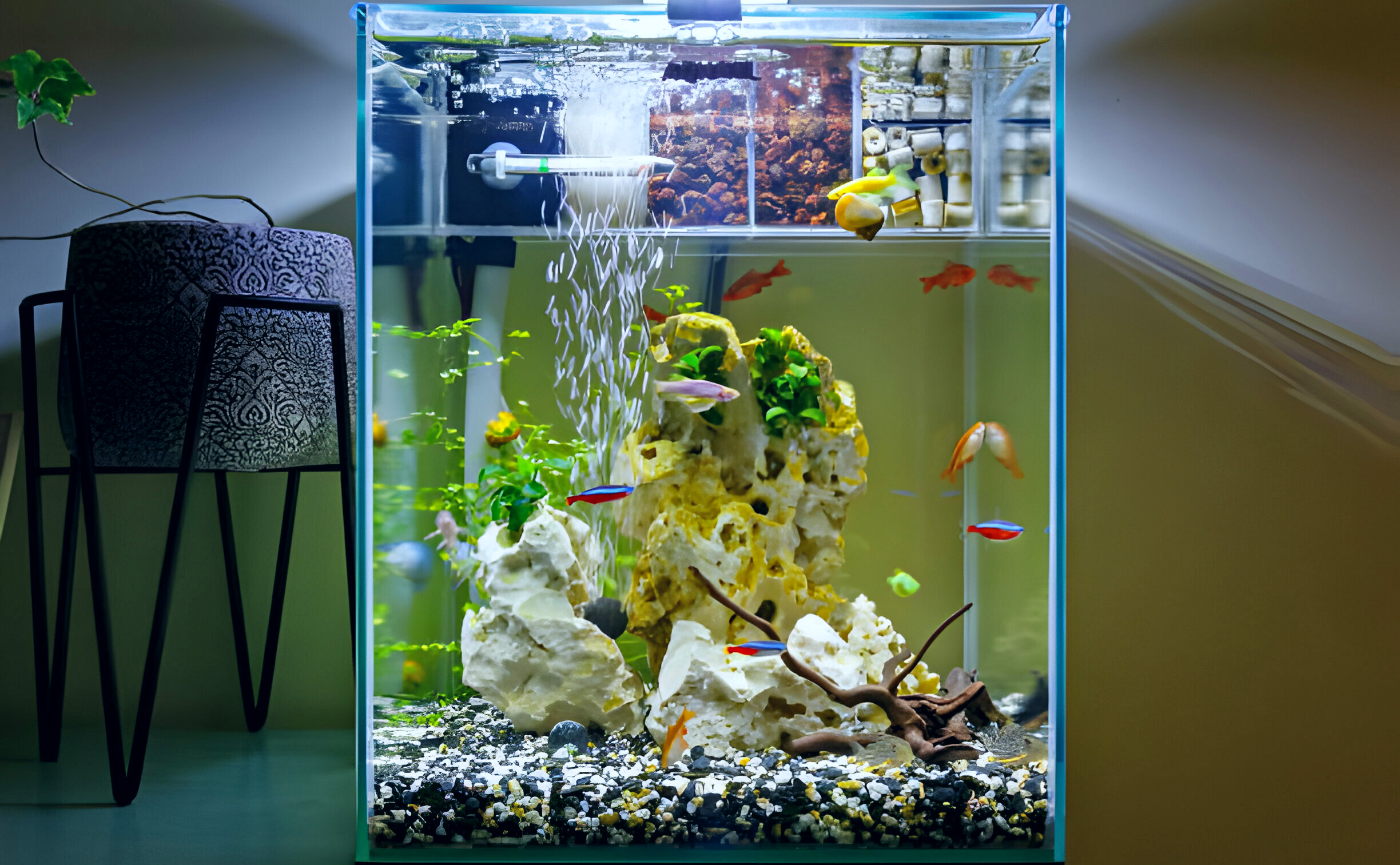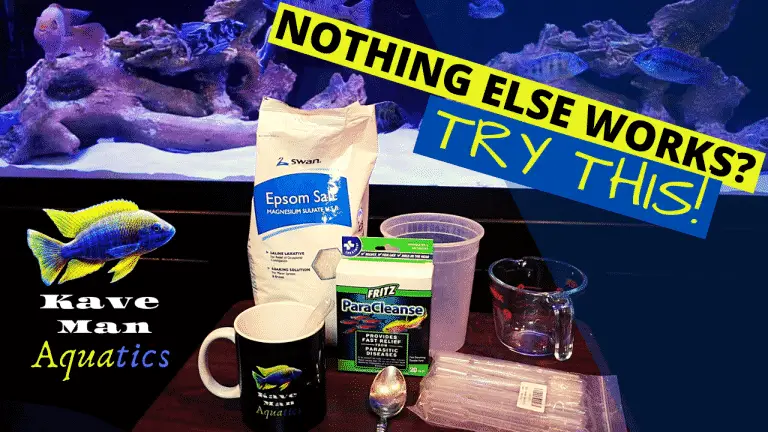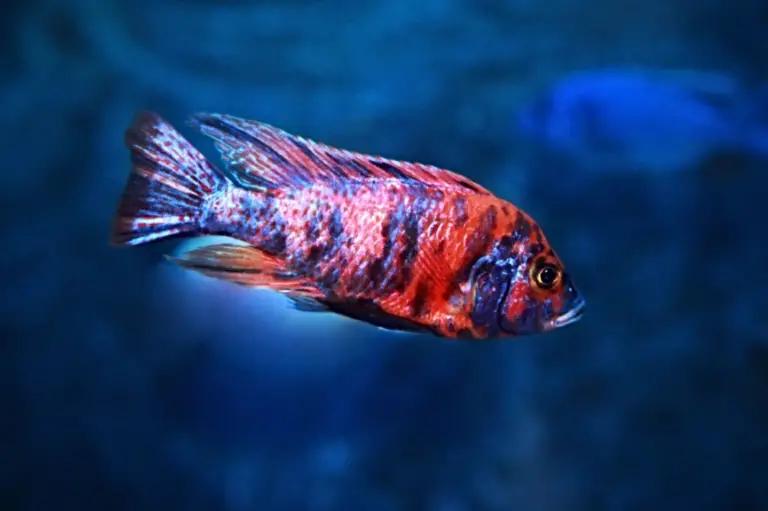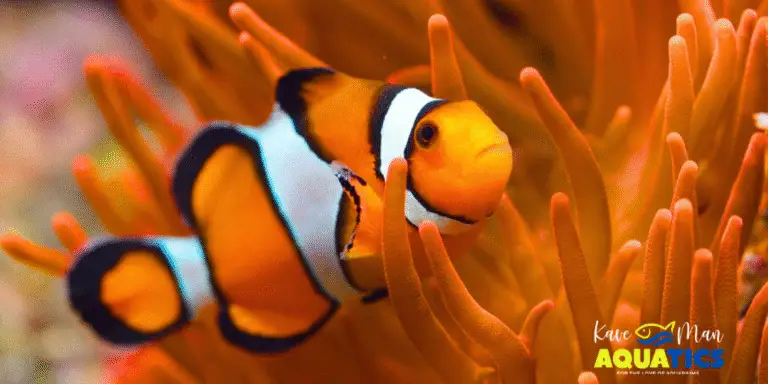Your Complete and Simple Guide to Nano Aquariums
If you’ve ever dreamt of diving into the captivating world of fish-keeping but hesitated due to limited space or resources, you’re in the right place. Nano aquariums have been making waves in the hobbyist community for their compact size and boundless potential. But before you dive headfirst into the nano aquarium craze, it’s essential to understand both the benefits and challenges that come with keeping one of these miniature underwater ecosystems.
In this guide, we’ll take you on a deep dive into the world of nano aquariums, covering everything from choosing the right tank size to selecting the perfect fish and plants for your tiny aquatic oasis. So grab your snorkel and get ready to explore the fascinating world of nano aquariums!
What Is a Nano Aquarium?
Nano aquariums are small tanks ranging from 2 to 20 gallons in size. These compact tanks offer fish-keepers a space-saving solution without compromising on the beauty and tranquility of a larger aquarium setup. The allure of nano aquariums lies in their versatility and accessibility, making them appealing to both novice enthusiasts and seasoned aquarists seeking to expand their collection.
Plus, with advancements in technology and equipment, maintaining a nano aquarium has become more manageable than ever before. Whether you’re limited on space or simply intrigued by the idea of creating a small-scale aquatic masterpiece, exploring the world of nano aquariums promises a rewarding and fulfilling journey.
Pros and Cons of Nano Aquariums
When it comes to nano aquariums, like everything else in life, there are both upsides and downsides. Let’s dive into the nitty-gritty and weigh the pros and cons to help you decide if a nano aquarium is the right fit for you.
Pros:
- Space-saving: Nano aquariums are perfect for those tight on space, whether you’re living in a cozy apartment or have limited room on your office desk.
- Cost-effective: Setting up and maintaining a nano aquarium typically costs less than larger setups. From equipment to decorations, you’ll save some green while still enjoying the vibrant colors of your underwater world.
- Quick and easy maintenance: With less water volume to manage, regular maintenance tasks like water changes and cleaning are quicker and more manageable.
- Ideal for beginners: Nano aquariums are a great starting point for new fish-keepers. Their smaller size makes them less intimidating to maintain while still providing a rewarding experience.
Cons:
- Limited stocking options: Due to their smaller size, nano aquariums have limited space for fish and other aquatic creatures. You’ll need to carefully consider stocking options to ensure a healthy and balanced ecosystem.
- Less room for error: With less water volume, changes in water parameters can happen more rapidly in nano aquariums. It’s essential to stay vigilant and monitor water quality closely.
- Design challenges: Decorating a nano aquarium can be trickier due to limited space for plants and decorations. Finding the right balance between aesthetics and functionality may require some creativity.
Planning Your Nano Aquarium
Planning is key when it comes to setting up your nano aquarium. By taking the time to consider the following factors, you’ll set yourself up for success from the get-go.

Choosing the right location
First things first, think about where you want to place your aquarium. Consider factors like natural light, temperature fluctuations, and foot traffic. Avoid placing your tank in direct sunlight, as it can lead to algae growth and temperature fluctuations. Opt for a sturdy, level surface like a sturdy desk or stand that can support the weight of your tank.
Selecting tank material
When it comes to tank material, you have two main options — glass or acrylic. Glass tanks are durable and scratch-resistant, but they can be heavier and more prone to cracking. Acrylic tanks are lighter and more impact-resistant, but they can scratch more easily. Choose the material that best suits your needs and budget.
Essential equipment
Investing in the right equipment is crucial for a successful nano aquarium setup. You’ll need a filtration system to keep the water clean and healthy, a heater to maintain a stable temperature, and a reliable lighting system to support plant growth. Don’t forget essential accessories like a thermometer, water conditioner, and test kits to monitor water parameters.
Proper planning is essential for a successful nano aquarium setup. Take the time to research and gather all the necessary equipment before diving in. Consider your budget, space limitations, and desired aquascape aesthetic. By planning ahead, you’ll avoid common pitfalls and ensure a thriving nano aquarium that brings you joy for years to come.
How To Set up Your Nano Aquariums
Setting up your nano aquarium is an exciting journey into the underwater world, but it’s essential to get things right from the start to ensure a healthy environment for your aquatic friends. Here’s a step-by-step guide to help you navigate the setup process:
Step 1: Prepare your equipment
Gather all the necessary equipment, including your tank, filtration system, heater, lighting, substrate, decorations, and water conditioner. Make sure everything is clean and in working order before you begin.
Step 2: Add substrate and decorations
Start by adding your chosen substrate to the bottom of the tank. Rinse it thoroughly beforehand to remove any dust or debris. Then, carefully arrange your decorations, rocks, and driftwood to create a visually appealing aquascape.
Step 3: Install equipment
Install your filtration system, heater, and lighting according to the manufacturer’s instructions. Position them in the tank to ensure optimal water circulation and temperature distribution.
Step 4: Fill your tank with water
Fill the tank with dechlorinated water, leaving enough space at the top to prevent overflow when you add fish and decorations. Use a thermometer to monitor the water temperature and adjust the heater as needed.
Step 5: Cycle your aquarium
Cycling your nano aquarium is crucial for establishing a healthy ecosystem. Add a source of ammonia, such as fish food or ammonia drops, to kick-start the nitrogen cycle. Test the water regularly for ammonia, nitrites, and nitrates using a reliable test kit.
Step 6: Monitor water parameters
As the tank cycles, monitor water parameters closely to ensure they remain within safe levels for fish and plants. Keep an eye on ammonia and nitrite levels, as elevated levels can be harmful to aquatic life. Perform regular water changes to maintain water quality and remove any accumulated waste.
Step 7: Introduce fish and plants
Once the tank has cycled and water parameters are stable, it’s time to introduce fish and plants to your nano aquarium. Start with a few hardy species to avoid overloading the ecosystem, and gradually add more over time as the tank matures.
Best Fish for Nano Aquariums
When it comes to stocking your nano aquarium, choosing the right fish is crucial for maintaining a healthy and balanced ecosystem. Look for species that have traits ideal for small tanks, such as being small themselves, having a minimal bioload, being non-territorial, and able to thrive in groups.

Here are some top picks categorized by tank size:
20 gallons
- Betta Fish
- Neon Tetras
- Ember Tetras
- Harlequin Rasboras
- Endler’s Livebearers
10 gallons
- Dwarf Puffers (Pea Puffers)
- Fancy Guppies
- Corydoras Catfish
- Celestial Pearl Danios
- Chili Rasboras
5-6.5 gallons
- White Cloud Mountain Minnows
- Green Neon Tetras
- Boraras Brigittae (Chili Rasboras)
- Dwarf Rasboras (Boraras maculatus)
- Endler’s Livebearers
Under 5 gallons
- Betta Fish
- Endlers Livebearers
- Dwarf Mosquito Rasboras
- Least Killifish (Heterandria formosa)
- Pygmy Corydoras (Corydoras pygmaeus)
Best Plants for Nano Aquariums
Selecting the right plants for your nano aquarium is essential for creating a lush and vibrant underwater landscape. Nano tank plants should have certain traits to thrive in the limited space and provide a visually appealing environment for your fish. Look for plants that are small in size, slow-growing, and adaptable to varying water conditions.

Here are some popular choices along with their benefits:
- Dwarf Hairgrass (Eleocharis parvula): This carpeting plant stays small and forms a dense mat, making it perfect for foreground coverage. It provides hiding places for small fish and shrimp while adding a natural look to your nano aquarium.
- Java Moss (Taxiphyllum barbieri): Java Moss is a hardy and versatile plant that can be attached to driftwood or rocks to create natural-looking accents. It’s low-maintenance and provides cover for fry and shrimp, making it an excellent choice for nano tanks.
- Anubias (Anubias barteri): Anubias species are known for their broad, sturdy leaves and slow growth, making them ideal for nano aquariums. They can be attached to driftwood or rocks and tolerate low light conditions, making them suitable for beginners.
- Cryptocoryne species: Cryptocoryne plants are popular for their striking foliage and ease of care. They come in various shapes and sizes, making them suitable for nano tanks of all dimensions. Crypts add a pop of color and texture to your aquarium while providing shelter for fish and shrimp.
- Monte Carlo (Micranthemum tweediei): Monte Carlo is a compact and low-growing carpeting plant that adds a lush green carpet to the foreground of your nano aquarium. It’s relatively easy to maintain and spreads quickly, creating a dense carpet that enhances the visual appeal of your tank.
These are just a few examples of the many plants that thrive in nano aquariums. When selecting plants for your tank, consider factors like lighting, substrate, and water parameters to ensure they thrive in their new environment.
How To Maintain Your Nano Tank
Maintaining your nano aquarium is key to ensuring a healthy and thriving aquatic environment for your fish and plants. Regular maintenance tasks help prevent common issues and keep your tank looking its best. Here’s a guide to essential maintenance tasks and tips for keeping your nano tank in top condition:
- Regular water changes: Performing regular water changes is vital for removing toxins and replenishing essential nutrients in your nano aquarium. Aim to change 20-30% of the water every 1-2 weeks to maintain optimal water quality.
- Cleaning the filter: Your filter plays a crucial role in removing debris and maintaining water clarity. Clean the filter media regularly to prevent clogs and ensure proper filtration. Replace or rinse mechanical media as needed and avoid disturbing the beneficial bacteria in biological media.
- Vacuuming the substrate: Use a gravel vacuum to remove debris and waste from the substrate during water changes. This helps prevent the buildup of organic matter and reduces the risk of ammonia spikes and algae outbreaks.
- Pruning and trimming plants: Trim overgrown or decaying plant material to maintain the health and appearance of your aquatic plants. Pruning encourages new growth and prevents overcrowding, which can lead to nutrient deficiencies and algae growth.
- Monitoring water parameters: Regularly test the water parameters, including ammonia, nitrites, nitrates, pH, and temperature, using a reliable test kit. Keep a log of your test results to track any changes and address any issues promptly.
- Preventing algae: Algae growth is common in aquariums, especially nano tanks with limited space. To prevent algae outbreaks, maintain stable water parameters, avoid overfeeding, provide adequate lighting duration, and consider adding algae-eating organisms like snails or shrimp.
- Observing fish behavior: Pay attention to your fish’s behavior and appearance as they can indicate underlying health issues. Look for signs of stress, disease, or aggression and address any problems promptly to prevent spreading to other tank inhabitants.
FAQs
Got more questions? Check the following list of frequently asked questions — perhaps you’ll find the answer you’ve been looking for.
Q: How many fish can you have in a nano aquarium?
A: For nano aquariums (2-10 gallons), a useful guideline is to stock 1 inch of small, peaceful fish per gallon of water. However, always ensure species compatibility and consider the increased maintenance small tanks require to keep water conditions optimal.
Q: What are the best fish for a nano aquarium?
A: Popular choices include bettas, neon tetras, guppies, and small shrimp like cherry shrimp. The key is to choose species that are small, relatively peaceful, and can thrive in limited space.
Q: How often should I change the water in a nano aquarium?
A: Regular water changes are crucial, generally recommended to change about 10-25% of the water every week to maintain optimal water quality.
Q: What type of filtration is best for a nano aquarium?
A: Sponge filters, hang-on-back filters, and small canister filters are commonly used in nano tanks. The choice depends on the type of livestock and personal preference for maintenance level.
Q: Can I have live plants in a nano aquarium?
A: Absolutely! Live plants can thrive in nano tanks and help maintain water quality. Suitable species include Anubias, Java fern, and mosses which are low maintenance and can adapt to smaller spaces.
Q: Is it harder to maintain a nano aquarium than a larger tank?
A: Nano aquariums can be challenging due to their small water volume, which can lead to quicker changes in water parameters. Consistent monitoring and maintenance are key.
Q: What equipment do I need to start a nano aquarium?
A: Essential equipment includes a tank, filter, lighting (especially if you plan to grow plants), heater (for tropical setups), and a thermometer. Optionally, a water test kit is highly recommended.
Q: How do I cycle my nano aquarium?
A: Cycling involves establishing beneficial bacteria that will convert ammonia to nitrites and then nitrates. This is usually done by adding ammonia sources (like fish food or pure ammonia) and testing the water until it shows zero ammonia and nitrites.
Q: What are the common problems with nano aquariums?
A: Common issues include algae growth, fluctuations in water parameters, and limited space for fish. Frequent monitoring and careful stocking can help manage these challenges.
Set up Your Nano Aquarium With Aquabuildr!
Owning a nano aquarium is a rewarding journey filled with joys and challenges. While these small tanks offer a glimpse into the fascinating underwater world, they also require dedication and attention to detail. Remember, every setback is an opportunity to learn and grow as a fish-keeper.
And to make your fish-keeping experience even more enjoyable and effortless, be sure to check out Aquabuildr, the ultimate companion for building and maintaining your aquarium. With Aquabuildr’s intelligent algorithm, you can create custom tanks tailored to your preferences and receive personalized recommendations for compatible fish species.
Download the app from the Google Play Store or Apple App Store for FREE!
-
Your Complete and Simple Guide to Nano Aquariums
Big things come in small packages! Learn the secrets of nano aquariums with our complete guide. Learn how Aquabuildr can help.







